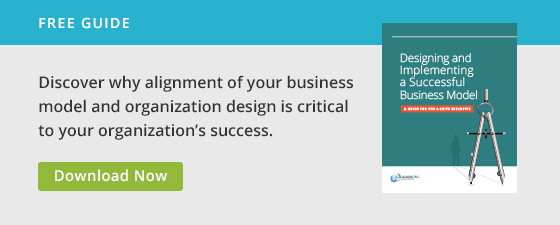As organization design consultants, one of our primary functions is to lead clients through the many choices involved in the organization design decision making process. For example, a key question that might be considered by an organization includes “will we structure an organization around product lines, or regions, or functions?” This is just the tip of the iceberg of the types of design decisions that need to be made.
Sometimes, there is no one single answer to questions like these. For many organizations, any one of the above options could work. The question then becomes, which of several good options is the best?
To answer that question, we turn to strategy.
How Strategy Facilitates Organization Design Decision Making
A good strategy works like a road map to help arbitrate design choices that will lead to desired results. To continue the above example of how best to organize the business, we can ask: what does our strategy say we are trying to do? If we are trying to be a product leader, and our strategy is telling us we will win if we have the best products, then we will likely want to organize around our products or product categories. If instead our strategy is anchored around customers, relationships, or local presence, a customer-centric model or perhaps a regional model might be better choices.
Following the classic design maxim “form follows function,” strategy thus dictates which choices are best in a given situation, and it helps us select the best option from a number of viable options. However, practitioners and leaders need to be aware of two common situations that can interfere with this process.
Design Criteria are No Substitute for Strategy
Practitioners have historically used design criteria to make design decisions. This isn’t necessarily bad; design criteria can be very useful in many instances. However, they are not always strategic. For example, one design criterion commonly applied to organization design is to avoid increasing cost (for example, by adding head count). This may be a good general rule of thumb, but if a constraint like that is set in stone and that’s what dictates design choices, it can cause leaders to leave some very good and viable design options on the table. This is because just “not adding cost” is a constraint for the business, not a strategy: it doesn’t indicate anything about how the organization is going to win. In other words, you can’t constrain yourself into growth.
So to return to our example, we can keep our cost structure controlled no matter whether we decide to organize the business around customer, product, or region—it still hasn’t helped us decide which best aligns with our strategy. Design criteria alone are not sufficient in organization design decision making. They are helpful, but the true arbitrating feature needs to be the strategy.
Clarity is Key
Another thing that can interfere with good strategic decision making in organization design is lack of strategic clarity. While every organization claims to have a strategy, strategies are often created without sufficient clarity to make viable organization design choices.
When we make design choices, we are essentially making choices about how to allocate limited resources to meet business goals. A vague strategy doesn’t answer clearly enough “how” to do this satisfactorily. For instance, saying “we’re going to grow by 30%”, may be a great goal, but it doesn’t give enough information to indicate whether we should organize by customer segments or product or geography.
A really good strategy to help with organization design decision making is one that would help you choose between options and make the choice that would best enhance and enable growth. We see many strategies that are numerically based or are focused just on operational outcomes that may sound good at the outset, but that don’t indicate how the organization will win the marketplace. To do that, you need a strategy that differentiates your organization.
Winning Through Strategic Design Choices
Sometimes, leaders look to practitioners to do their organization design decision making for them. In reality, the job of a practitioner is not to tell leaders what to do, but to help them make good decisions—including showing them how to tie their design choices back to the strategy. Leaders need to understand the implications of their strategy so they can continue to make good choices going forward. And, they need to be sure that the organization design choices they make truly enable their strategy and help their organizations win.






